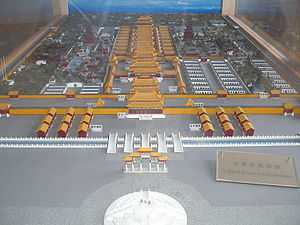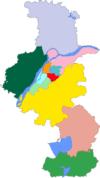Presidential Palace (Nanjing)



The Presidential Palace (simplified Chinese: 总统府; traditional Chinese: 總統府; pinyin: Zǒngtǒng fǔ) in Nanjing, China, housed the Office of the President of the Republic of China before the republic relocated to Taiwan in 1949. It is now a museum, the China Modern History Museum. It is located at 292 Changjiang Road, in the Xuanwu District of Nanjing.
History
In the Ming Dynasty, this site was the location of two successive ducal palaces. In the Qing Dynasty, it became the Office of the Viceroy of Liangjiang (simplified Chinese: 两江总督; traditional Chinese: 兩江總督), the chief government official in charge of what is today Jiangsu, Anhui, and Jiangxi.
In 1853, Taiping Revolution forces led by Hong Xiuquan occupied Nanjing. The palace was expanded and converted into a palace for Hong, the Palace of the Heavenly King, or Tianwang Fu. In 1864, Qing imperial forces re-took Nanjing. Commander Zeng Guofan ordered that most of the palace be razed, and a new office of the Governor-General be erected in accordance with government protocol.
After the Xinhai Revolution in 1911, Sun Yat-sen was sworn in at the Presidential Palace as the provisional President of the Republic of China.
However, China soon fell into Warlord era and the Palace was not officially used until 1927 when the Kuomintang (KMT)'s Northern Expedition captured Nanjing and made it into the Headquarters of the Nationalist Government. Chiang Kai-shek had his office in the palace. During the Second Sino-Japanese War (1937–1945), Chiang Kai-shek's government fled to Chongqing and the building was occupied by Wang Jingwei who collaborated with the Japanese. Following the Japanese surrender in 1945, Chiang Kai-shek's Nationalist Government reoccupied the building. In 1947, the Constitution of the Republic of China was promulgated and the Headquarters of the Nationalist Government was renamed the Office of the President.
In 1949, near the end of the Chinese Civil War, the Communist forces captured Nanjing, Chiang Kai-shek's government fled to Taiwan, and Mao Zedong declared the People's Republic of China with capital in Beijing. The building was then used for government functions. In the late 1980s it was transformed into a museum detailing China modern history. It is now one of the few places in mainland China where the Flag of the Republic of China is publicly displayed.
On April 27, 2005, the Chairman of Kuomintang, Lien Chan, visited the Palace on his trip to Mainland China, marking a symbolic return of the party to the Palace for the first time in 58 years.
See also
- List of museums in China
- Presidential Building (Taipei)
External links
| Wikimedia Commons has media related to Presidential Palace at Nanjing. |
- China Modern History Museum
- Presidential Palace, from Nanjing city government
Coordinates: 32°2′43″N 118°47′32″E / 32.04528°N 118.79222°E
